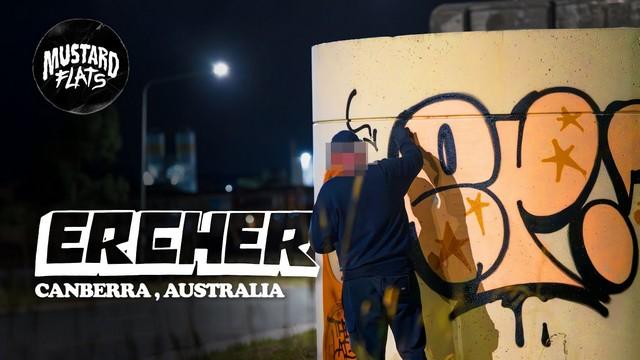
Mustard Flats x ERCHER
Mustard Flats went for a ride along with one of Canberra’s most prolific writers, ERCHER, to find out why he does what he does. Much is said about graffiti in our city, but we don’t often get to hear from the people doing it.
What drives them? What does the culture represent?
Love it or hate it, graffiti is embedded in the fabric of every city—and Canberra is no exception. It reflects the underbelly of our culture and contributes to many aspects of our lives, whether you notice it or not. It’s a practice that’s in your face—the audience is forced to see it—so understandably, it has its champions and its detractors.
Some say it brings life to the shadows, highlights inequality, and democratises art so that it’s accessible to anyone. No need for the keys to gated institutions or access to studios and facilities. While it’s “for the people,” it’s also inherently about damage and destruction—a big part of the appeal for die-hard practitioners.
Many argue it contributes to crumbling infrastructure, costs taxpayers, and leads to a life of escalating crime—bringing down the communities in which it exists. Others argue quite the opposite.
What’s undeniable is the dedication, passion, and drive that writers have to get their name up and seen. Because of the illegal nature of the activity, media rarely gets to hear from the artists themselves. This is an insight into one of those voices, and we thank ERCHER for sharing his story.
For ERCHER, graffiti falls somewhere in the middle between art and vandalism. It’s still considered. There is pride in the work, combined with the rush and adrenaline of its illegal nature. He’s not an “artist” or a “painter,” but he finds the art in graffiti.
Mustard Flats believes it’s important to record and document all aspects of culture to understand the real stories of the people who live here. We aim to capture the history of Canberra’s arts—regardless of social standing, background, or beliefs.
We want to explore things outside of what is considered an “acceptable form” and tell their stories to understand where they come from. This is happening, and we cover the things that happen in the city. Documentary journalism.
However, we do not condone or encourage vandalism, property damage, or dangerous acts.
Do not attempt.

